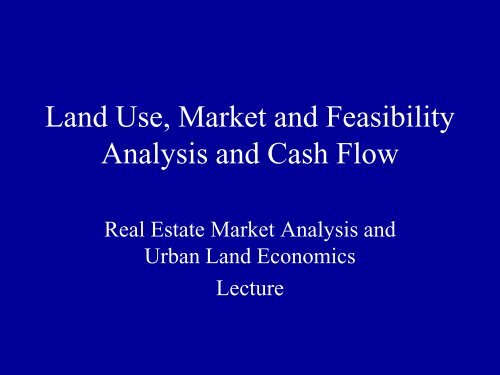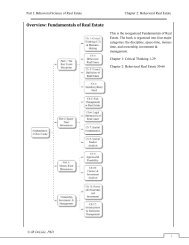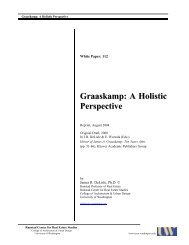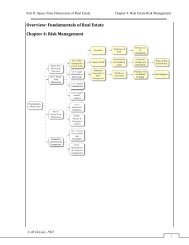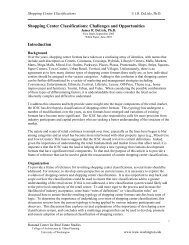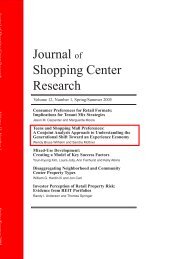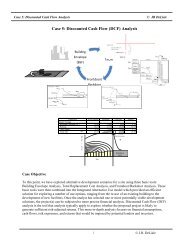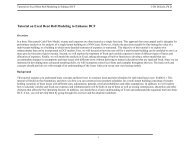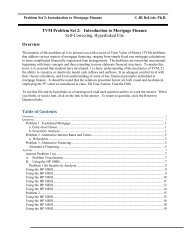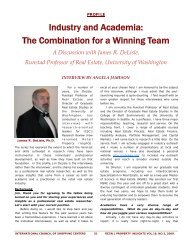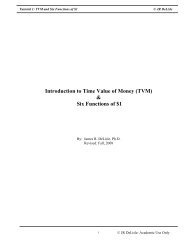Land Use, Market and Feasibility Analysis and Cash Flow
Land Use, Market and Feasibility Analysis and Cash Flow
Land Use, Market and Feasibility Analysis and Cash Flow
Create successful ePaper yourself
Turn your PDF publications into a flip-book with our unique Google optimized e-Paper software.
<strong>L<strong>and</strong></strong> <strong>Use</strong>, <strong>Market</strong> <strong>and</strong> <strong>Feasibility</strong><br />
<strong>Analysis</strong> <strong>and</strong> <strong>Cash</strong> <strong>Flow</strong><br />
Real Estate <strong>Market</strong> <strong>Analysis</strong> <strong>and</strong><br />
Urban <strong>L<strong>and</strong></strong> Economics<br />
Lecture
<strong>Market</strong> <strong>Analysis</strong><br />
Objectives<br />
The Student will know how to:<br />
• Make the link of l<strong>and</strong> use to product delineation as a basis of<br />
supply, which in turn is related to user dem<strong>and</strong> to form a<br />
foundation for specifying asset capacity <strong>and</strong> the estimation of<br />
potential cash flow<br />
• Introduce market analysis as it applies to spatially delineated<br />
markets as defined by Situs.<br />
• Develop dem<strong>and</strong> analysis<br />
• Develop supply analysis as a Function of Situs<br />
• Conduct the analysis of market interaction; absorption <strong>and</strong><br />
capture analysis<br />
• <strong>Use</strong> market value <strong>and</strong> cost to develop cash flow proforma<br />
projections
A Site in Search of <strong>Use</strong> or <strong>Market</strong><br />
Numerous Possible <strong>Use</strong>s<br />
Productivity <strong>Analysis</strong><br />
Physical, Legal, Locational<br />
<strong>Market</strong> <strong>Analysis</strong><br />
Supply <strong>Analysis</strong><br />
Dem<strong>and</strong> <strong>Analysis</strong><br />
Decision Model<br />
Value, Solvency, Rates<br />
<strong>Use</strong> or Value Conclusion<br />
Source: Grissom <strong>and</strong> Diaz 1991
A <strong>Use</strong> or <strong>Market</strong> in Search of a site<br />
Identification of <strong>Market</strong><br />
<strong>Market</strong> <strong>Analysis</strong><br />
Supply <strong>Analysis</strong><br />
Dem<strong>and</strong> Anaysis<br />
Productivity <strong>Analysis</strong><br />
Physical, Legal, Locatonal<br />
Decision Model<br />
Value, Solvency, Rates<br />
<strong>Use</strong> or Value Conclusion<br />
Source: Grissom <strong>and</strong> Diaz 1991
Real Estate as an Investment Alternative: An Asset Class<br />
Risk <strong>and</strong> Return Objectives<br />
Decision St<strong>and</strong>ards<br />
Decision Models<br />
Value, Solvency, Rates<br />
<strong>Market</strong> Option <strong>Analysis</strong><br />
Supply <strong>Analysis</strong><br />
Dem<strong>and</strong> <strong>Analysis</strong><br />
Productivity <strong>Analysis</strong><br />
Physical, Legal, Locational<br />
Appropriate Site or Property Type<br />
Source: Grissom <strong>and</strong> Diaz 1991
Nature of Real Estate Practice <strong>and</strong> Decisions<br />
As per Fanning, Grissom <strong>and</strong> Pearson (1991), in<br />
Practice the Real Estate Business is driven by<br />
specifics <strong>and</strong> tactical operations with a focus on:<br />
• The uniqueness of the property<br />
• The agents (parties) in the transactions<br />
• <strong>Use</strong> for a site<br />
• Number of uses in area<br />
• Association between uses<br />
• The expected uses<br />
• The link of these criterion to the economic<br />
measures
Productivity <strong>Analysis</strong><br />
Concept <strong>and</strong> Tool:<br />
• Productivity <strong>Analysis</strong> considers <strong>and</strong> evaluates<br />
a property’s capacity to deliver services <strong>and</strong><br />
satisfactions to meet the requirements of<br />
human needs for space, house economic<br />
activities <strong>and</strong> supply satisfactions <strong>and</strong><br />
amenities.<br />
• It defines <strong>and</strong> links the needs of economic <strong>and</strong><br />
social activities with the use of space
The Building Envelope: Physical-Legal<br />
Restaurant
The Building Envelope: Physical-Legal
Location: Situs <strong>Analysis</strong><br />
Rationale for <strong>and</strong> key components of Situs analysis<br />
assist practical application because:<br />
• The concept of a site is economic. The site is not<br />
just the physical parcel of l<strong>and</strong>, but its economic<br />
situation.<br />
• This requires in situ analysis. Appropriately done,<br />
situs analysis enables the internalization of external<br />
factors influencing value, profit <strong>and</strong> return.<br />
• Situs can be approached as a decision theory model<br />
<strong>and</strong> an applied approach to be used in the analysis<br />
of given parcels of property relating product to the<br />
market.
Situs Theory<br />
Broadly defined, Situs is the total urban<br />
environment in which a specific urban l<strong>and</strong> use<br />
on a specific l<strong>and</strong> parcel functions <strong>and</strong><br />
interacts at a specific time.<br />
• The total urban environment means the whole<br />
of urban activities <strong>and</strong> relationships that can<br />
impact specific functions. It involves factors<br />
external to the site, externalities, that influence<br />
the economic performance of a parcel <strong>and</strong> its<br />
use.
Situs Theory<br />
• Situs theory rest on the assumption that l<strong>and</strong><br />
uses are interdependent <strong>and</strong> economic<br />
activities are interrelated (basis of externalities<br />
<strong>and</strong> endogenous factors).<br />
• Despite Interrelations, a key idea is that a l<strong>and</strong><br />
use of a given parcel <strong>and</strong> the locus of the<br />
parcel are separate.<br />
• A site can be physically fixed but<br />
economically flexible in terms of its use.<br />
Flexibility is considered with proximity <strong>and</strong><br />
accessibility as inferior goods of loci.
Situs as a Process<br />
Situs as a process is comprised of four steps<br />
that involve the gathering, classification, <strong>and</strong><br />
analysis of information for location analysis.<br />
The steps are:<br />
1. Identify the key activities in the area.<br />
2. Study the nature of the associations<br />
between these activities<br />
3. Analyze the accessibility of the site to the<br />
surrounding area<br />
4. Identify <strong>and</strong> evaluate the environmental<br />
impact of the total area on the site use
Situs Theory/Process<br />
Activities<br />
Associations<br />
Site Rent or<br />
Value<br />
Accessibility<br />
Environment
Situs as a Process<br />
Activities:<br />
Activity analysis can range from a simple<br />
survey of existing l<strong>and</strong> uses to a major<br />
economic base study. The objective is:<br />
• identify <strong>and</strong> delineate the key activities in a<br />
given area. Quantify by frequency (probability)<br />
or magnitude of use.<br />
• The activities that characterize a<br />
neighborhood are those that attract people to a<br />
specific location or market.<br />
• Primary activities often define the character of<br />
a neighborhood <strong>and</strong> the basis of the<br />
neighborhood’s economy.
Situs as a Process<br />
Associations<br />
Associations characterize the nature of the<br />
relationships among the various activities in<br />
the subject neighborhood boundaries. The<br />
nature of the relationship among any set of<br />
l<strong>and</strong> uses is determined by their economic<br />
function.<br />
<strong>L<strong>and</strong></strong> uses will tend to cluster, to group in<br />
order to exploit the benefits of positive<br />
externalities.
Situs Process: Associations - Agglomeration<br />
• This clustering is called the economics of<br />
agglomeration. This is a grouping of key activities<br />
that increases the draw power of an area, the<br />
services of goods available <strong>and</strong> the free-rider<br />
benefits derived from proximity.<br />
• Agglomeration increases economic choice.<br />
Agglomeration economics allows the capture of<br />
non-market priced benefits of location (benefits<br />
which are not directly priced or taxed).
Situs: Categories of <strong>L<strong>and</strong></strong> <strong>Use</strong> Associations<br />
• Dominant use/subordinate use:<br />
Subordinate uses serve the function/operation of<br />
the dominant activity.<br />
• Dominant use/ancillary use:<br />
The ancillary activity serves the clients <strong>and</strong><br />
employees of the dominant uses.<br />
• Co-dominant uses (or dominant uses) /satellite<br />
uses:<br />
the activities serve the same functions or<br />
client/users, but can vary in size. The satellite uses<br />
compete with the dominant uses, but the<br />
agglomeration benefits increases choices <strong>and</strong><br />
enhances draw.
Situs Process: Accessibility<br />
Accessibility<br />
Accessibility addresses the degree of convenience or<br />
inconvenience involved in moving people, goods <strong>and</strong><br />
services between different loci of activity. It is:<br />
• the measure of movement convenience; level of<br />
difficulty is represented as economic friction.<br />
• Friction is measured in terms of time cost, monetary<br />
cost <strong>and</strong> aggravation.<br />
• Accessibility is akin to negative transportation cost;<br />
the more accessible a site to major activities <strong>and</strong><br />
complementary l<strong>and</strong> uses, the lower the cost to access<br />
<strong>and</strong> higher potential return in income (rents) <strong>and</strong><br />
market value.
Situs Process: Accessibility<br />
Accessibility at two levels:<br />
• Macro-level Accessibility<br />
• Micro-level Accessibility
Situs Process: Accessibility<br />
Macro: flow from one area to another within the city.<br />
Measured as a trade-off between transportation costs<br />
(TC) <strong>and</strong> the specific features <strong>and</strong> amenities of the<br />
site:<br />
• Like gravity model; TC modified by draw of<br />
dominant use or use mix<br />
• frequency of inward/outward movements<br />
• Urban use mix <strong>and</strong> hierarchy (city)<br />
Key predictive Macro tool: Zone of Conflux<br />
• Activity pull; strong draw (people/activities/uses)<br />
• Infrastructure pattern promotes an assemblage<br />
(inward) movement
Situs Process: Accessibility<br />
Micro: the objective of most real estate accessibility<br />
analysis is micro-level – access to immediate area <strong>and</strong><br />
site; direct access vs. circuity travel; ingress-egress.<br />
Micro-level accessibility is concerned with linkage<br />
relationships:<br />
• Movement between linked establishments –measure<br />
with volume, number of reoccurring & frequency of<br />
trips: traffic volume<br />
• Issues of proximity – nearness (time/distance); ingressegress<br />
• Measures: money/time cost (opportunity cost) adjusted<br />
by route, route orientation, mode (public/private,<br />
method), congestion
Situs Process: Accessibility<br />
• Micro: Nature of linkage relationships on<br />
movement patterns:<br />
• Assembling movement - movement characterized<br />
by convergence on a focal point<br />
• Dispersion movement - spreads out from a focal<br />
point<br />
• R<strong>and</strong>om movement pattern - goods, services or<br />
people are dispersed among various locations along<br />
a route.<br />
Key predictive Micro tool: Trapping Points<br />
• A Micro - Zone of Conflux<br />
• Strong pull - by good infrastructure, <strong>and</strong> design<br />
features
Situs: Environment<br />
The environment component of situs accounts for the<br />
context in which site uses, their associations <strong>and</strong><br />
accessibility interact. The context can be categorized as:<br />
• Physical environment<br />
• Legal environment<br />
• Political environment<br />
• <strong>L<strong>and</strong></strong> use environment<br />
• Social-Cultural environment<br />
• Technical Environment<br />
• Economic environment<br />
• Institutional environment<br />
Urban Structure
Dynamic, Behavioral or Psychological Dimensions<br />
Dynamic Attributes are concerned with behavioral<br />
responses of people involved in producing real estate <strong>and</strong><br />
delivering real estate related activities.<br />
On-site Dynamic Attributes:<br />
• Functional Layout:<br />
• Personal Response Factors<br />
• Hazardous Conditions<br />
• Design Implications<br />
Off-site Dynamic Attributes:<br />
Transportation Access<br />
Exposure of site <strong>and</strong><br />
Structure<br />
Tributary Area <strong>Analysis</strong><br />
Personal Response<br />
Factors
<strong>Market</strong> <strong>Analysis</strong> as Strategic Organization<br />
• The consumer or space user (specifying the<br />
dem<strong>and</strong> function) is the drive wheel within the<br />
process or system.<br />
-as a tangible/life style product, the needs, taste<br />
<strong>and</strong> preferences of the ultimate users (or defined<br />
investment group) must be identified.<br />
-this requires the entrepreneurial skills of<br />
recognizing <strong>and</strong> exploiting trends in consumer<br />
needs <strong>and</strong> preferences <strong>and</strong>/or<br />
-the creative skills of innovation, problem solving<br />
<strong>and</strong> timely delivery.
<strong>Market</strong> <strong>Analysis</strong> as Strategic Organization<br />
Given that the objective is to reduce or manage uncertainty<br />
while optimizing return <strong>and</strong> profit, then the:<br />
Personal skills to strengthen are:<br />
• To acquire or exercise the abilities of observation,<br />
creativity <strong>and</strong> analytical interpretation <strong>and</strong><br />
• Opportunistic behavior <strong>and</strong> a forward looking<br />
mentality/perspective, based on an organized process<br />
which:<br />
1. identifies the constraints <strong>and</strong> context of the situations<br />
<strong>and</strong><br />
2. then focus on manageable portions controlled <strong>and</strong><br />
manipulated with reasonable effort.
Spatial <strong>Market</strong> <strong>Analysis</strong><br />
(Basic constraints <strong>and</strong> context of real estate)<br />
Spatial constraints <strong>and</strong> <strong>Market</strong> Structure:<br />
The spatial context <strong>and</strong> limited data force the recognition<br />
of imperfect competition <strong>and</strong> at best an oligopolistic<br />
structure in specifying decision models.<br />
In general Real Estate markets reflect an Oligopolistic<br />
market for all property types<br />
In Atlanta, a monopolistic competitive structure can be<br />
identified for Single Family Residential <strong>Market</strong>s
Applied Spatial <strong>Market</strong> <strong>Analysis</strong><br />
Segment Spatial units into:<br />
• Primary<br />
• Secondary<br />
• Tertiary sectors<br />
Spatial breakdown assist in supply <strong>and</strong> dem<strong>and</strong><br />
analysis;<br />
• Primary focus on key activities that<br />
characterize the nature of neighborhood<br />
• Identify nature of associations between<br />
activities – assist in specifying competition<br />
• Investigate demographics
Applied Spatial <strong>Market</strong> <strong>Analysis</strong><br />
• the key concern of market analysis is to reduce<br />
aggregate data ( population, income) into<br />
factors/measures that are relevant to a specific<br />
site, neighborhood, client or target market<br />
information.<br />
• Linking the product attributes to the target<br />
market needs <strong>and</strong> preferences is the focus of<br />
merch<strong>and</strong>izing analysis.
Applied Spatial <strong>Market</strong> <strong>Analysis</strong><br />
• merch<strong>and</strong>izing analysis; linking productive capacity<br />
Linking attributes to targeted dem<strong>and</strong> potential<br />
enables a focus on primary data, even if<br />
aggregated/secondary data is all that is available.<br />
• Productivity analysis helps delineate the array of<br />
competitive possibilities for any given parcel of real<br />
estate.<br />
• <strong>Market</strong> segmentation by area <strong>and</strong> locational attributes<br />
• <strong>Market</strong> segmentation by property type <strong>and</strong> physical<br />
attributes<br />
• <strong>Market</strong> segmentation by legal/regulatory attributes<br />
• <strong>Market</strong> segmentation by design/amenity attributes<br />
• <strong>Market</strong> segmentation by probable users <strong>and</strong><br />
demographic attributes
Applied Spatial <strong>Market</strong> <strong>Analysis</strong><br />
Specific delineation techniques<br />
Retail (applies to all property types)<br />
• Ring Studies: Insights to Dem<strong>and</strong> measures<br />
(see NINIS, NISRA)<br />
• Reilly’s Law of Retail Gravitation: Dem<strong>and</strong><br />
<strong>and</strong> Supply<br />
• Applebaum customer spotting technique<br />
• Nelson Retail Location technique
Applied Spatial <strong>Market</strong> <strong>Analysis</strong><br />
Office<br />
• City core versus suburban location<br />
• Single tenant vs. Multi-tenant<br />
• Quality rating or requirements (A,B,C,D)<br />
• Credit rating of tenants<br />
• Dunn <strong>and</strong> Bradstreet (prestige/risk)<br />
Class or quality of office space - based on:<br />
1. Quality of construction<br />
2. Condition<br />
3. Design/Architectural appeal<br />
4. age built<br />
5. Location
Applied Spatial <strong>Market</strong> <strong>Analysis</strong><br />
• Dem<strong>and</strong> <strong>Analysis</strong> for Merch<strong>and</strong>izing<br />
Analytics<br />
An Example:<br />
• boundaries are established with the delineation<br />
of the market area,<br />
• the context from which to seek demographic<br />
characteristics.<br />
• For example assume the trade area comprises<br />
three census tracts.
Dem<strong>and</strong> <strong>Analysis</strong> for Merch<strong>and</strong>izing Analytics<br />
Census Tracts<br />
Population<br />
Income per<br />
Capita<br />
Income in Area<br />
Pop/Income<br />
Percentage<br />
20.1 3500 £ 4,500 £15,750,000 41.18%/29.85%<br />
20.2 3000 £ 5,000 £15,000,000 35.29%/28.44%<br />
22.0 2000 £11,000 £22,000,000 23.53%/41.71%<br />
Total Area<br />
Income<br />
£52,750,000 100%<br />
Estimate<br />
60% of income in area/city is spent on retail, Based on Sales Management: Survey of<br />
Buyer Power, See in Pullen Libarary or WEB. This can be adjusted within a given city<br />
<strong>and</strong> its many neighborhoods based upon the differences between the average income<br />
for the metroplex <strong>and</strong> a given market trade area.
Dem<strong>and</strong> <strong>Analysis</strong> for Merch<strong>and</strong>izing Analytics<br />
Consumer Profile Example:<br />
1 75% of the families earned annually: £ 20,000 to £45,000<br />
2 Family Mean Income: £ 30,000<br />
3 Income per capita: Bi-modal; £4,750 £ 1,000<br />
4 Average level of education achieved 15.7 years<br />
5 Percentage attending school over 16<br />
years:<br />
22.9%<br />
6 State employees: 49%<br />
7 Percentage of renters living in 2 to 9<br />
unit dwellings:<br />
49%<br />
8 Percentage of population renters 75%<br />
9 Average monthly rent: £ 450.00
Dem<strong>and</strong> <strong>Analysis</strong> for Merch<strong>and</strong>izing Analytics<br />
Consumer Profile Example:<br />
10 Percentage in single-unit,<br />
Detached garage dwellings:<br />
11 Percentage of owner-occupants that<br />
have been there 20 years or more:<br />
12 Percentage of renter-occupants that<br />
have been there 1 year or less:<br />
23%<br />
49%<br />
67%<br />
13 Percentage pop. That walk to work 83%<br />
14 Percentage of renters that are Husb<strong>and</strong>-wife families 22%<br />
15 Percentage of population in the18-24 year range 56-77%<br />
16 Population growth rate<br />
Growth potential<br />
-2% (pop<br />
decline 517)<br />
low/tran-<br />
sitional
Retail <strong>and</strong> Consumption<br />
Categories<br />
Retail <strong>and</strong> Other Income Allocations<br />
For County<br />
The County Percentage of<br />
Disposable Income<br />
Dollar Expenditure<br />
per Good Grouping<br />
Total Retail Sales 54.03% £7,085,637,000<br />
Food 8.01% £1,050,552,000<br />
Eat& Drink Places 4.96% £650,381,000<br />
General Mdse 4.52% £592,347,000<br />
Furniture/Furnish/Appl 2.47% £323,970,000<br />
Automotive 18.84% £2,470,556,000<br />
Drug 1.91% £ 250,000,000<br />
Other 13.33% £ 1,747,831,000<br />
Housing 30.00% £ 3,933,957,000<br />
Saving <strong>and</strong> transportation 15.97% £ 2,093,596,000
Supply <strong>Analysis</strong><br />
• Supply analysis within spatially defined markets can be<br />
based on:<br />
- observation,<br />
- public information <strong>and</strong><br />
- involvement in community activities.<br />
• Process focus is the:<br />
-timing of the quantity <strong>and</strong> staging of competitive units as<br />
they come on line,<br />
-address timing <strong>and</strong> measures via risk management<br />
guidelines.
Supply <strong>Analysis</strong><br />
Model combining the measure, timing <strong>and</strong> risks of accounting for<br />
competitive supply is considered with the equation:<br />
Sf = πsVs + UC + πpP + d(t) + e<br />
πs = probabilities; πs is the percentage of<br />
units available<br />
πp = πp is the percentage experienced of<br />
proposed units actually constructed<br />
<strong>and</strong> marketed for use over time<br />
Vacant units may not immediately be available for<br />
tenant occupancy.<br />
Vs = Vacant units<br />
UC = units under construction<br />
P = Proposed units<br />
d = units being demolished in time (t)<br />
e = error term, possible spread in data<br />
developed over time
<strong>Market</strong> <strong>and</strong> Merch<strong>and</strong>izing <strong>Analysis</strong><br />
<strong>Market</strong> Surveys of trade areas show that the<br />
proportion of consumers patronizing<br />
• 1. a given center or shopping area varies with<br />
distance from center<br />
• 2. classification of shopping area varies with<br />
the breadth <strong>and</strong> depth of merch<strong>and</strong>ise offered<br />
• The distance that consumers travel to centers<br />
vary for different types of product purchases<br />
• The draw of any given shopping area is<br />
influenced by proximity of competing<br />
shopping areas
<strong>Market</strong> Area Specification <strong>and</strong> Gravity<br />
The survey findings identify primary variables<br />
quantifiable by parameters defining gravity<br />
models. Gravity models allow the following<br />
mathematical market insights:<br />
• Reilly Model of Consumer shopping movements<br />
between sites/centers:<br />
Allows the calculation of the comparative<br />
proportion of consumer business located between<br />
two (or more) centers or shopping areas that are<br />
drawn to a designated center (relative to<br />
competition).
<strong>Market</strong> Area Specification <strong>and</strong> Gravity<br />
Reilly Competitive Capture Model:<br />
Ba = Pa * Db<br />
2<br />
Bb Pb Da<br />
Ba = proportion of intermediate consumer<br />
business attracted to Center A<br />
Bb = proportion of intermediate consumer<br />
business attracted to Center B<br />
Da = distance from interim customer to A<br />
Db = distance from interim customer to B
<strong>Market</strong> Area Specification <strong>and</strong> Gravity<br />
Reilly’s Law of Retail Gravitation: Converse’s<br />
adaptation:<br />
• Breaking Point between competitive locations;<br />
communities or shopping centers where A<br />
signifies the subject or location of concern <strong>and</strong> B<br />
is the competition. Note that even though A is the<br />
focus of the analysis, the boundary delineation<br />
begins with the loss of distance from the<br />
competition (B).
<strong>Market</strong> Area Specification <strong>and</strong> Gravity<br />
Converse Breaking Point <strong>and</strong> MA Boundary:<br />
Distance or<br />
Driving time from<br />
Breaking Point time<br />
A to B (Dab)*<br />
B to A = ----------------------------------<br />
_________________<br />
/ Center A Size (Pa)<br />
1 + /-----------------------<br />
√ Center B Size (Pb)<br />
* measured from B
Gravity Model: <strong>Market</strong> Area Calculation<br />
Drive<br />
<strong>Market</strong><br />
Between<br />
Time<br />
Split<br />
Centre<br />
Size<br />
Total<br />
Drive<br />
time B & A Subject<br />
1 350000 42 18.5437 23.4562<br />
2 180000 34 12.3017 21.6982<br />
3 210000 28 10.6342 17.3657<br />
Subject =A 560000 0 0 0<br />
Total 130000
Competitive Centers Trade Areas: (1, 2, & 3)<br />
to consider impact on Proposed Center X<br />
<strong>Market</strong> Interaction Effects <strong>and</strong> Reilly Share<br />
2<br />
1<br />
X<br />
3
Gravity Model: Reilley<br />
Center 2<br />
180,000 SF<br />
Center 3<br />
210,000 SF<br />
12.3 min<br />
21.7 min<br />
10.63 min<br />
X Subject<br />
Subject<br />
560,000 SF<br />
560,000 SF<br />
17.37 min<br />
23.56 min<br />
Center 1<br />
18.54 min<br />
350,000 SF
Gravity Model: <strong>Market</strong> Area Calculation<br />
B<br />
A<br />
Centre<br />
Size (SF)<br />
Drive<br />
Time<br />
Portion<br />
to: B<br />
Subject<br />
1 350000 42 18.5437 23.4562<br />
2 180000 34 12.3017 21.6982<br />
3 210000 28 10.6342 17.3657<br />
Subject =A 560000 0 0 0<br />
Total 130000
Basis of Real Estate Value<br />
Strategic Implications of Bid Rent Curves:<br />
• There is a hierarchy of <strong>L<strong>and</strong></strong> <strong>Use</strong> <strong>Market</strong>s based<br />
on Pricing <strong>and</strong> Site rents – <strong>Use</strong>s dominate<br />
market segments<br />
• Despite hierarchies, prices paid by separate<br />
uses are interdependent<br />
• Situs theory: Relationship of the total urban<br />
environment as it relates to a specific l<strong>and</strong> use<br />
on a specific parcel of l<strong>and</strong> as they function in<br />
time
<strong>Market</strong> Areas <strong>and</strong> Situs<br />
• Gravity Model <strong>Analysis</strong> shows the relationships of<br />
location, activity cluster size (mass) <strong>and</strong> pull to access<br />
<strong>and</strong> distance in terms of spatial market analysis.<br />
• This information can be linked to <strong>and</strong> associated with<br />
the bid rent map. This allows a consideration of the<br />
general spatial patterns of specific l<strong>and</strong> uses <strong>and</strong> their<br />
interrelationships:<br />
- across the total urban environment <strong>and</strong><br />
-specific segments of the urban complex
Basis of Real Estate Value: Basic Bid Rent<br />
Curve Model – defining <strong>L<strong>and</strong></strong> <strong>Use</strong> Patterns by<br />
Trade-off Location <strong>and</strong> Accessibility<br />
Site Rent<br />
Income<br />
Allocated<br />
to Location<br />
<strong>and</strong><br />
Accessibility<br />
Site Rent<br />
Transportation<br />
Costs<br />
Agricultural <strong>and</strong> Direct return to Physical <strong>L<strong>and</strong></strong><br />
CBD Distance from CBD<br />
Economic Edge of City
Basis of Real Estate Value: Basic Bid Rent<br />
Curve: Patterns of Trade-off of Site Rent <strong>and</strong><br />
Accessibility Vary with <strong>L<strong>and</strong></strong> <strong>Use</strong><br />
Site Rent<br />
Office<br />
Income<br />
Allocated<br />
to Location<br />
<strong>and</strong><br />
Accessibility<br />
Retail<br />
Industrial<br />
Transportation<br />
Costs<br />
Site Rent<br />
Residential<br />
Agricultural <strong>and</strong> Direct return to Physical <strong>L<strong>and</strong></strong><br />
City Centre<br />
Economic Edge of City
Other Measures of Economic <strong>L<strong>and</strong></strong>scape<br />
• Density Gradient: Population Per capita per SF<br />
• Transportation Gradient: Comparison of Traffic <strong>Flow</strong> Counts<br />
Traffic<br />
Counts<br />
200000<br />
Pattern of Traffic <strong>Flow</strong> I-20<br />
1999-2000<br />
180000<br />
160000<br />
140000<br />
120000<br />
100000<br />
80000<br />
2 4 6 8 10 12 14 16 18 Miles
Basis of Real Estate Value: Examples of<br />
Atlanta <strong>Market</strong> Segments<br />
Rent/SF<br />
32<br />
28<br />
24<br />
Atlanta Quality Office North<br />
Buckhead<br />
CBD<br />
Midtown<br />
Central Perimeter<br />
20<br />
16<br />
Roswll/North Fulton<br />
12<br />
0 5 10 15 20 25 30<br />
Distance from CBD
Atlanta Real Estate in an Asset Pricing<br />
Context: Office <strong>Market</strong>s<br />
Rent Multipliers <strong>and</strong> Risk Measures:Atlanta Office Submarkets<br />
Income Multipliers<br />
11.0<br />
10.5<br />
10.0<br />
9.5<br />
9.0<br />
N Fulton/Forsyth<br />
Buckhead<br />
Chamblee/<br />
Dorv/N.D. Hills<br />
Duluth/<br />
Suwanee/Buford<br />
Cumberl<strong>and</strong>/Galleria<br />
Norc/Ptree Corners<br />
Midtown/<br />
Pershing Point<br />
CBD Atlanta<br />
Perimeter<br />
8.5<br />
.008 .012 .016 .020 .024<br />
Risk(STD)
Basis of Real Estate Value: Examples of<br />
Atlanta <strong>Market</strong> Segments<br />
Rents/ft<br />
20<br />
18<br />
16<br />
14<br />
12<br />
10<br />
8<br />
Retail Bid Rent Curve North of CBD<br />
CBD<br />
Midtown<br />
S<strong>and</strong>y Springs/<br />
Dunwoody<br />
Buckhead<br />
Roswell/<br />
Alpharetta<br />
Cumming/<br />
Forsyth Co.<br />
0 4 8 12 16 20 24<br />
Miles from CBD
Basis of Real Estate Value: Examples of Atlanta<br />
<strong>Market</strong> Segments<br />
Interrelationships of <strong>L<strong>and</strong></strong> Pricing Patterns:<br />
Bid Rents/SF<br />
36<br />
32<br />
28<br />
24<br />
20<br />
16<br />
12<br />
8<br />
4<br />
0<br />
Comparative Bid Rent Curves<br />
Office Bid Rent Curve<br />
Midtown<br />
Buckhead<br />
Central Perimeter<br />
Retail Bid Rent Curve<br />
2 4 6 8 10 12 14 16 18 20<br />
Distance from CBD
Basis of Real Estate Value: Examples of<br />
Atlanta <strong>Market</strong> Segments<br />
Rent/SF<br />
28<br />
Comparative Retail Bid Rent Patterns by Center Type<br />
24<br />
Neighborhood Centers<br />
20<br />
16<br />
Aggregated Retail Rent North<br />
Community Centers<br />
12<br />
Neighborhood Strip Centers<br />
Centers<br />
8<br />
1 2 3 4 5 6 7 8 9 10<br />
Source: Grissom GSU RERC<br />
Distance CBD
Community Center Retail Bid Rent Curve<br />
Rents/SF<br />
13.8<br />
13.6<br />
Community Center Rents North of CBD<br />
CBD<br />
Midtown<br />
13.4<br />
13.2<br />
Buckhead<br />
S<strong>and</strong>y Springs/<br />
Dunwoody<br />
13.0<br />
12.8<br />
12.6<br />
Roswell/<br />
Alpharetta<br />
Cummings/<br />
Forsyth Co.<br />
0 4 8 12 16 20 24<br />
Miles from CBD
Neighborhood Center Retail Bid Rent Curve<br />
Rent/SF<br />
20<br />
18<br />
Neighborhood Centers North of CBD<br />
Midtown<br />
16<br />
14<br />
12<br />
10<br />
8<br />
CBD<br />
Buckhead<br />
S<strong>and</strong>y Springs/<br />
Dunwoody<br />
Roswell/<br />
Alpharetta<br />
Cummings/<br />
Forsyth Co.<br />
0 4 8 12 16 20 24<br />
Miles from CBD
Strip Center Retail Bid Rent Curve<br />
Rents/SF<br />
15<br />
14<br />
13<br />
12<br />
11<br />
10<br />
9<br />
8<br />
7<br />
Strip Center Rents North of CBD<br />
CBD<br />
Midtown<br />
Buckhead<br />
S<strong>and</strong>y Springs/<br />
Dunwoody<br />
Roswell/<br />
Alpharetta<br />
Cummings/<br />
Forsyth Co.<br />
0 4 8 12 16 20 24<br />
Miles from CBD
Linear Industrial Bid Rent Pattern<br />
Rent/<br />
SF 6.5<br />
6.0<br />
Atlanta Industrial <strong>L<strong>and</strong></strong> Rent Curve<br />
Chamblee<br />
Duluth<br />
5.5<br />
5.0<br />
4.5<br />
Norcross<br />
CBD<br />
Doraville<br />
Lawrenceville<br />
Buford<br />
4.0<br />
Suwanee<br />
Gainsville<br />
3.5<br />
0 10 20 30 40 50 60<br />
Distance<br />
CBD
Basis of Real Estate Value: Examples of<br />
Atlanta <strong>Market</strong> Segments<br />
Rent/SF<br />
Atlanta Metro Industrial <strong>L<strong>and</strong></strong> Rent Curve<br />
6.5 Chamblee<br />
Duluth<br />
6.0<br />
5.5<br />
5.0<br />
CBD<br />
Norcross<br />
Doraville<br />
Buford<br />
4.5<br />
4.0<br />
Lawrenceville<br />
Suwanee<br />
Gainesville<br />
3.5<br />
0 10 20 30 40 50 60<br />
Distance from CBD


